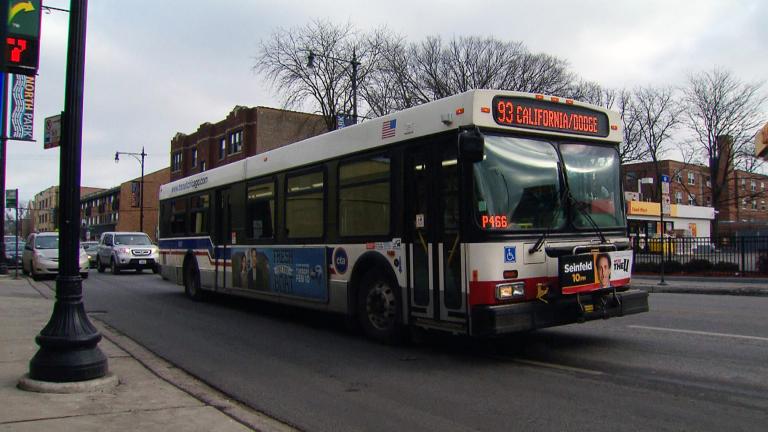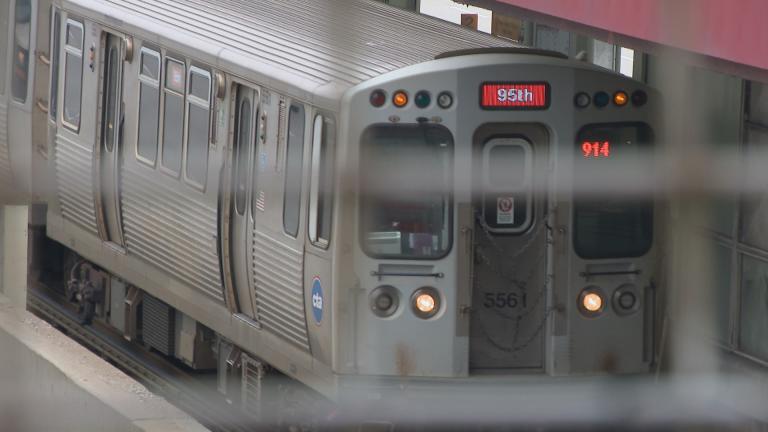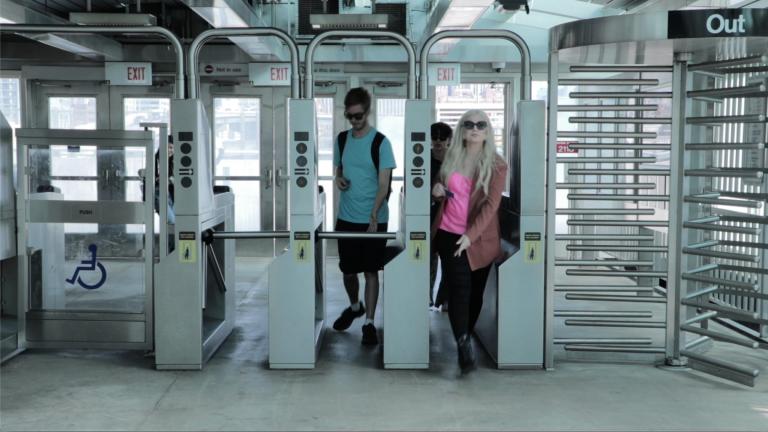Update, March 14, 2024: This story was originally published on Dec. 5, 2022. In March 2024, CTA officials issued a blanket correction to the data they originally provided, which the agency mischaracterized as comprising a straight-time accounting of operator hours. In fact, the agency has subsequently told WTTW News that the hours provided contained the so-called “OT multiplier” used to calculate the time and a half employees earn when they work overtime. The CTA’s error means the overtime hours reported in this article are not necessarily directly reflective of the exact number of hours an employee worked.
The Chicago Transit Authority is under fire from passengers and politicians complaining about long waits, inconsistent service and so-called ghost buses and trains.
Many of those problems are driven by a severe staffing shortage, a gap the CTA has filled in part using an ever-increasing amount of overtime.
A WTTW News analysis of CTA bus and train operator work records from 2015 to 2021 shows a growing number of employees paid for long average workweeks, which experts say raises questions about worker and passenger safety and the agency’s bottom line.
The records cover how many hours each year operators were paid for, which the CTA says includes paid time off and authorized breaks.
In 2015, less than 5% of the agency’s operator workforce was paid an average of 50 or more hours a week. By 2021, that number jumped to nearly 14%.
Thirty-three of those operators were paid for average workweeks of 80 hours or more – double a standard 40-hour week.
Last year, one train operator was paid for an average workweek of more than 100 hours, netting more than $200,000 – nearly three times the standard yearly rate.
The CTA declined an interview request, but in written comments said, “Even as the CTA takes steps to overcome industry-wide hiring and retention challenges, providing safe operations and safe service are and have been CTA’s top priority. … CTA workplace rules, which are in keeping with labor contracts and industry best practices, are in place to ensure that CTA rail and bus operators can safely and responsibly carry out their duties, while still allowing them to pursue opportunities for extra income.”
But sleep experts say even with safeguards in place, long hours can have damaging effects.
One stark example occurred in 2014, when a Blue Line operator pulling into O’Hare fell asleep at the controls, slamming into a post and landing on an escalator. Thirty-three passengers were hurt.
Leading up to the crash, that operator had worked twelve consecutive days and had regularly requested overtime.
Dr. Kenneth Lee, medical director of UChicago Medicine’s sleep center, says long hours and not enough time off are likely to cause some degree of sleep deprivation even if you’re getting some sleep at night.
“If this continues on for several days or several weeks, your judgment is significantly impaired,” Lee said.
After the Blue Line crash, the National Transportation Safety Board called on the CTA to make big changes to its policies on how long and how often operators can work.
At the time, the agency only required employees to have eight hours off between shifts.
“CTA’s practice … does not give the employees the opportunity to receive enough uninterrupted sleep to be fully alert and operate safely,” the NTSB wrote in its report.
The CTA says it tried to extend the mandatory break to 10 hours, but told WTTW News: “a court ruling forced the CTA to pursue this desired change via union negotiations, which it did at the earliest opportunity. The unions representing CTA’s bus and rail operators did not agree to the change.”
One union didn’t respond to a request for comment, the other wouldn’t discuss overtime.
“Given the millions of miles CTA buses and trains travel every year, CTA has a strong safety record that is in line with our peers nationally,” the CTA said in a statement, citing the National Transit Database record of crashes maintained by the federal government. “Importantly, despite the increase in over-time hours in recent years, the number of major safety events (accidents) reported by the CTA have steadily declined since 2019, and through June-2022 are on-pace to continue that trend.”
Still, sleep experts say long hours can be detrimental.
“Especially in overnight shifts, (if) you look historically with things such as Chernobyl or Three Mile Island, all of those happened (on) overnight shifts,” Lee said. “Now, there’s a lot of circumstances as to that but again, the bottom line from sleep medicine being that it’s really important to make sure that you’re getting optimal sleep in order to maintain your peak performance.”
The agency also said employees are required to complete training on fatigue and sleep apnea. And the CTA noted there aren’t any federal or state rules regarding hours on the job that apply – though the agency said it’s been advocating for those rules to increase its ability to prevent fatigue and safety issues.
Dr. Victor Muñoz of Loyola Medicine says many of his patients across different industries have been working longer hours and taking on more shifts.
“Short term, if they’re working a double shift here and there, it might throw the patient off a little bit, but if they’re doing it for a long period of time, that could cause a burn out,” Muñoz said.
That can also contribute to high blood pressure and blood sugar, and hurt someone’s mental health.
“It’s a gradual onset. It’ll be stressful at first, possibly go to anxiety, and then to depression,” Muñoz said. “And also family time (and) relationships is another part of the mental aspect.”
The CTA told WTTW News that in addition to a minimum of eight hours between shifts, operators cannot work longer than five and a half hours without taking a 30 to 60 minute break. Per its union contract, operators cannot work longer than 13 hours per shift unless management asks them to in emergency situations and the operator doesn’t show signs of fatigue.
“Everybody has different attention spans and that could definitely affect it,” Muñoz said. “Especially if they’re in charge of machinery, drivers, that kind of thing.”
In the years since the O’Hare crash, records show the agency’s workforce has dwindled from a combined peak of 5,124 bus and rail operators in 2019 to a low of 4,580 last year. And the number of operators being paid for significantly longer than 40 hours a week has risen steadily.
Among the 48 employees paid out for average workweeks of 80 hours or more over the last several years, more than two-thirds of them logged at least one crash or safety violation between 2015 and 2021, records show. Four of them were involved a serious accident or injury.
“It’s not to say that all drivers that are on overtime are going to have accidents,” said Northwestern University professor Andy Crosby. “(But) if you’re driving 80 hours a week, you may be more likely to have an accident than if you’re driving 40 hours a week.”
In addition to highlighting its record of declining crashes, the CTA noted that safety violations “comprise a much broader, more comprehensive universe than events in which there was property damage, injury, or citations issued by law enforcement.”
“CTA has an extensive list of safety rules and procedures that all operators must follow, covering myriad aspects of bus and rail operations. Any violation of those rules can result in a safety violation. For example, an employee can be issued a safety violation for failing to report defective equipment, or failing to wear or use proper personal protective equipment (PPE),” the agency said in a statement.
One weekday morning in June 2019, a bicyclist was heading south on Wells near Hubbard. He was struck and run over by a CTA bus and rushed to the hospital. The bus driver who struck the cyclist was on overtime.
The driver had twice ranked among the drivers paid for the most hours in a year. Hitting the cyclist was his second on-the-job crash. He was fired after an investigation and the CTA later settled a lawsuit the cyclist filed for $1.75 million.
In March 2019, a CTA bus struck a pedestrian crossing Washington just west of the Chicago River. She also sued the CTA, accusing the driver of negligence. The agency settled her suit for an undisclosed amount.
The driver who struck that pedestrian has regularly been among the drivers paid out for the most hours. After the crash, the driver admitted to being distracted and took full responsibility. Records show he told his manager that going forward, he’d work less overtime.
But records show otherwise.
In 2019, the year of that crash, that driver was paid for an average of 66 hours a week. In 2020, he was paid for an average of 85 hours a week, and then an average of 89 hours a week last year.
“Anecdotally, we hear lots of stories from operators about how burnt out they get by having to do so much overtime,” said Chris Van Eyken from the nonprofit organization TransitCenter. “Operators really want to have downtime like anybody else. And when they finish their job, they would like to go home and see their family and friends.”
It’s not just a question of safety or paying out settlements after crashes. Overtime for CTA bus and train operators also means big bucks. Their hourly pay during regular time topped out at $36, and overtime pays out at time-and-a-half.
“Overtime is built into the operations of transit,” said Paul Skoutelas, president and CEO of the American Public Transportation Association. “There’s absenteeism, there’s time off for vacations and so forth. It makes sense to fill that through over time rather than hiring new people. … The challenge now, of course, is that this is on top of a very difficult time of having lost riders, having lost revenue and so the cost associated with having to incur more overtime, I think, takes on added significance.”
The CTA’s gone over budget on bus and train operator overtime every year since 2015. Most of that overtime comes from bus drivers – rising from $7.7 million in overtime costs in 2015 to $13.1 million in 2021.
“Not only does that make us pay more for less employees, but it also means in terms of (the CTA’s) pension plan, if employees have a lot of overtime that can also be counted towards their final years of pay,” Crosby said. “Then the CTA pension plan is paying out that money over the long term.”
Counting overtime toward public employee pensions is unique to CTA employees in Illinois. At the beginning of the year, the CTA’s pension plan was 55% funded.
“In general, 80% is considered a reasonable number to be funded,” Crosby said.
By law, the plan has to get to 60% in 10 years and 90% by 2059. Its administrator told WTTW News in a statement it’s on track to exceed those requirements, adding: “Not all employees are earning high overtime and the Retirement Plan uses the average of an employee’s four highest years when calculating benefits, which blunts the impact of a single high year.”
Both employees and the agency contribute to the plan. This year, the CTA was projected to make $136 million in contributions.
“It’s not to say the employees don’t deserve overtime, but it is something that is a long-term cost for the CTA,” Crosby said. “A lot of overtime now might solve the short-term crisis of, we need operators, and certainly we do … but it could create a longer-term budget implication.”
Note: This article will be updated with video.
Contact Nick Blumberg: [email protected] | (773) 509-5434 | @ndblumberg








